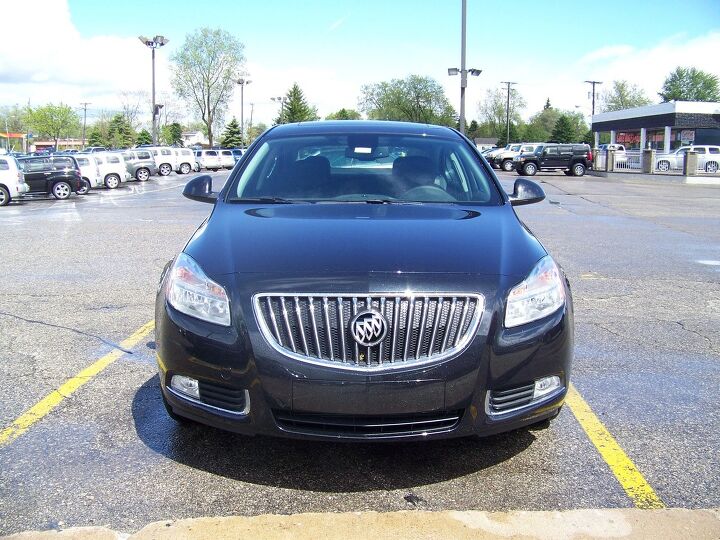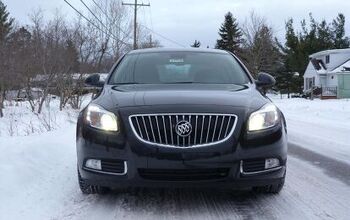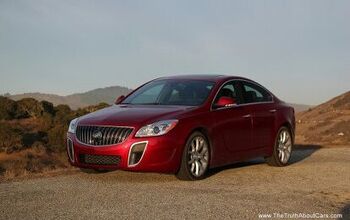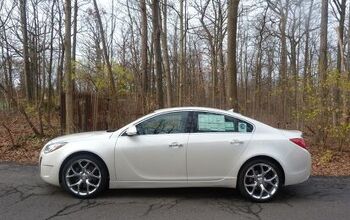Review: 2011 Buick Regal
With Pontiac and Saturn gone, Buick must assume a larger role within General Motors. It must now seek to win over enthusiasts who would have previously bought Pontiacs and the import-intenders who previously bought Saturns. The first product to follow from this expanded mission: the new 2011 Buick Regal. The Regal began life as the Opel Insignia—it will even be imported from Germany for the first year—and was to be marketed in the United States as the second-generation Saturn Aura. But it has been available in China as the Buick Regal for over a year now, so putting the tri-shield on the grille isn’t entirely an afterthought. This isn’t even the first time Opel has manufactured a car for Buick dealers—this tie goes way back. Even so, is the Regal a plausible Buick?
When I first saw the new Regal, in China, it really stood out. But the Chinese still get the rest of the world’s hand-me-downs. The circa 1985 MkII Volkswagen Jetta continues to be sold as a new car there, and decade-old designs are common. So recently designed cars tend to stand out. In the American context, the Regal blends. Yes, it’s handsome, but the same can be said for other clean, chunkily-proportioned, Audi-influenced sedans. The Suzuki Kizashi comes to mind. Thanks to a basically curvy shape, the Opel Insignia looks much more like a Buick than the similarly imported Opel Omega looked like a Cadillac, but this isn’t saying much. Within the Buick family, the Regal has been stuck with the role of Jan. Those seeking a distinctively styled car that is clearly a Buick will opt to date the family’s Marcia, the LaCrosse.
Inside the new Regal, the story is the same, with a more conventional, more straightforward design than you’ll find in the LaCrosse. Materials are better than the GM norm, and are certainly a step or two up from those in the Saturn Aura, but aren’t quite up to those in the Acuras and Audis GM hopes to steal buyers from. White stitching on the
seats and upholstered door panel inserts and numerous chrome details provide welcome contrast within the “ebony” (i.e. black) interior—though the thick chrome shifter surround might be a bit much. Unlike in the LaCrosse, there is no stitching on the instrument panel or the upper door panels. The various elements of the IP cohere and flow together much better than they did in the Saturn Aura this car was to replace. Piano black trim runs along the base of the windshield to trace a continuous arc from door to door and also flows down into the center console from a band that runs mid-level across the instrument panel. For those who find the dark interior overly dark—and many potential buyers likely will, despite the contrasting bits—Buick offers a two-tone cocoa/cashmere interior with faux wood trim.
The Regal’s relatively conventional interior design pays functional dividends. Thanks to the car’s lower instrument panel and thinner (but still not thin) pillars, it’s much easier to see out of the Regal than the LaCrosse. The shifter is better positioned. And the various controls are easier to reach—though in the Regal as in the button-laden LaCrosse it’s often a challenge to find the one you’re looking for.
Oddly, while Cadillac no longer offers 4-way power lumbar adjustments in the CTS or SRX, Buick offers this feature in both the Regal and the LaCrosse. And yet the Regal’s moderately firm front seats aren’t especially comfortable, and only a German might find them luxurious. It doesn’t help that the headrests are very firm and jut too far forward in the interest of cheap whiplash protection. The bolsters provide a bit of lateral support, but in the GM fashion are too widely spaced for the average driver. Sure, the same could be said about the seats in a number of competing cars—it’s not easy finding great seats. But seats used to be a Buick focus.
Compared to the LaCrosse, the Regal rides on a four-inch-shorter wheelbase and, at just over 190 inches in length, is nearly seven inches shorter overall. These dimensional differences most impact rear seat room. While the LaCrosse offers 40.5 inches of rear legroom, the Regal provides 37.3, about average for a midsize car. Six-footers will fit, but the flat rear seat cushion is mounted far too low to provide thigh support—blame the fashionably arched roofline. One welcome premium feature: rear air vents.
Jan always was more practical than Marcia. So perhaps it should not come as a surprise that, with 14.2 cubic feet of cargo volume, Regal actually has a slightly larger
trunk than the LaCrosse. In both cars GM opted for conventional gooseneck hinges, then fully encased the paths taken by these hinges to yield an especially narrow space. Why? Just to save a few dollars per car? Those who like big butts trunks will go elsewhere.
Partly to differentiate the Regal from the LaCrosse, Buick won’t offer the smaller sedan with a V6. The only engine currently available: a 182-horsepower direct-injected 2.4-liter. At 3,600 pounds, the new Regal could stand to lose a few (hundred), but the normally-aspirated four moves two tons (with driver and passenger) well enough in typical around town driving, and without making noises unbecoming a Buick. Most drivers won’t feel the need for more power.
For those who do, a 220-horsepower turbocharged 2.0-liter four will arrive in the fall. Initially, as with the 2.4, a manually-shiftable six-speed automatic that isn’t always the smoothest operator is the only transmission. A six-speed manual will be available “for order” with the turbo in late 2010—don’t expect dealers to stock any. The turbo gets a different steering system that adds variable assist and adaptive shocks with “sport” and “tour” settings will be optional. Farther into the future a Regal GS will combine a 255-horsepower turbo four with a six-speed manual and all-wheel-drive. What do you know, Buick is seriously pitching this car at enthusiasts.
To an even greater degree than the specs suggest, the Regal feels more compact and lighter than the LaCrosse. The steering is a little heavier, feels tighter and more precise, and provides more feedback. There’s more body roll than in the performance-oriented LaCrosse CXS, but also a smoother, more composed ride. Chassis tuning is a Regal strongpoint—something not typically expected from Buick. When it’s taken up a notch with the turbo and manual transmission, the Regal should prove a very fun car to drive.
For the first year, because it will be imported from high-cost Germany, the Regal will only be offered in mid-level CXL trim. The starting price of $26,995 jumps to $28,840 when you add the tested car’s sunroof and Convenience Package (power passenger seat, rear obstacle detection, AC outlet). A V6-powered LaCrosse CXL is about $2,500 more, according to TrueDelta.com’s car price comparison. A similarly-equipped four-cylinder Honda Accord? About $500 less sticker-to-sticker, and about $1,800 less invoice-to-invoice—Buick dealers have much less margin to play with. Adjusting for the Regal’s higher content cuts the difference by about $600.
Buick would rather you compare the Regal to the Acura TSX. Do this and you’ll find that the Buick is about $1,300 less sticker-to-sticker, but only about $600 less invoice-to-invoice. The Buick has about $200 in additional content. So it appears that the Regal isn’t badly priced, but also isn’t likely to sell based on price.
The Regal CXL Turbo will start at $29,495, but aside from the turbo this price will also include the $845 Convenience Package. So the turbo adds a very reasonable $1,655, and will undercut a similarly equipped Volkswagen CC, the closest European competitor, by about $4,000.
Overall, the new Regal looks and feels more like an Audi (with VW materials) than a Buick, while being priced midway between Honda and Acura. It’s a solid car with large number of standard features and a very good ride-handling compromise. But does it have what it takes to bring people who never saw themselves driving a Buick into Buick showrooms? As much as a German car at Japanese prices has a certain appeal, it’s perhaps too subtle. This formula certainly didn’t work with the Saturn Astra. More of the LaCrosse’s style or of the luxury for which Buick has traditionally been known would help. Or perhaps adding boost will do the trick, at least for those who enjoy driving? We’ll find out later this year.
Michael Karesh owns and operates TrueDelta, an online source of automotive reliability and pricing data
Michael Karesh lives in West Bloomfield, Michigan, with his wife and three children. In 2003 he received a Ph.D. from the University of Chicago. While in Chicago he worked at the National Opinion Research Center, a leader in the field of survey research. For his doctoral thesis, he spent a year-and-a-half inside an automaker studying how and how well it understood consumers when developing new products. While pursuing the degree he taught consumer behavior and product development at Oakland University. Since 1999, he has contributed auto reviews to Epinions, where he is currently one of two people in charge of the autos section. Since earning the degree he has continued to care for his children (school, gymnastics, tae-kwan-do...) and write reviews for Epinions and, more recently, The Truth About Cars while developing TrueDelta, a vehicle reliability and price comparison site.
More by Michael Karesh
Latest Car Reviews
Read moreLatest Product Reviews
Read moreRecent Comments
- Ajla So a $10K+ transmission repair?
- Kwik_Shift_Pro4X I've mentioned before about being very underwhelmed by the Hornet for a $50000+ all in price tag. Just wasn't for me. I'd prefer a Mazda CX-5 or even a Rogue.
- MaintenanceCosts Other sources seem to think that the "electric Highlander" will be built on TNGA and that the other 3-row will be on an all-new EV-specific platform. In that case, why bother building the first one at all?
- THX1136 Two thoughts as I read through the article. 1) I really like the fins on this compared to the others. For me this is a jet while the others were propeller driven craft in appearance.2) The mention of the wider whitewalls brought to mind a vague memory. After the wider version fell out of favor I seem to remember that one could buy add-on wide whitewalls only that fit on top of the tire so the older look could be maintained. I remember they would look relatively okay until the add-on would start to ripple and bow out indicating their exact nature. Thanks for the write up, Corey. Looking forward to what's next.
- Analoggrotto It's bad enough we have to read your endless Hyundai Kia Genesis shilling, we don't want to hear actually it too. We spend good money on speakers, headphones and amplifiers!








































Comments
Join the conversation
I think that GM should have kept Pontiac instead of Buick and GMC. The old and respected Buick nameplate has outlived it's usefulness in today's world, pretty much like oldsmobile. With the exception of a few cars, like the Grand Sport and Grand nationals the Buick nameplate will always have that stigma as an elderly person's car, and that doesn't cut it in today's world.
This is the wrong car, at the wrong time, and at the wrong price. Let’s not even get into the fact it only offers v4 engines. This car will fail for the same reason the Astra failed for Saturn. Does GM really now think US consumers have the same preferences as their European counterparts. I give this car about 700 days until it fades away. GM - sigh.........